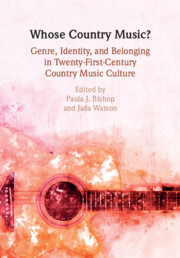Book contents
- Whose Country Music?
- Whose Country Music?
- Copyright page
- Contents
- Figures
- Tables
- Contributors
- “She went to Nashville to sing country music”
- Part I Industry
- Part II Codes of Conduct
- Part III Authenticity
- Part IV Boundary Work
- 13 Playing at the Border
- 14 Country-Loving Mexican Americans
- 15 Practices of Genre Surveillance in Country Music
- 16 “We Have a Lot of Work To Do”
- Epilogue
- Bibliography
- Index
Epilogue
Country Music Needs a Revolution
from Part IV - Boundary Work
Published online by Cambridge University Press: 03 February 2023
- Whose Country Music?
- Whose Country Music?
- Copyright page
- Contents
- Figures
- Tables
- Contributors
- “She went to Nashville to sing country music”
- Part I Industry
- Part II Codes of Conduct
- Part III Authenticity
- Part IV Boundary Work
- 13 Playing at the Border
- 14 Country-Loving Mexican Americans
- 15 Practices of Genre Surveillance in Country Music
- 16 “We Have a Lot of Work To Do”
- Epilogue
- Bibliography
- Index
Summary
Who knew that twenty-two years ago when I began this musical journey that I was making a political statement by just being myself, an eighteen-year-old Black girl from St. Louis, Missouri? In the epilogue, I recount my career thus far in Country music – the good, the bad, and the downright ugly. My journey from Eureka, Missouri, to songwriter’s nights in Nashville to a record deal and all the misadventures along the way. In telling my story, I examine the disparities that exist for women and Black, Indigenous, and artists of color in the country music industry and propose ideas for how to bridge and fill the gaps.
Keywords
- Type
- Chapter
- Information
- Whose Country Music?Genre, Identity, and Belonging in Twenty-First-Century Country Music Culture, pp. 256 - 263Publisher: Cambridge University PressPrint publication year: 2022

